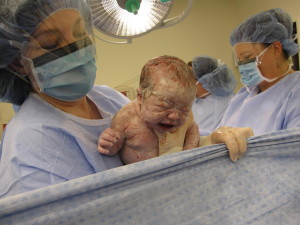
Although my first emergency c-section (5 years ago) and my 4th (planned) c-section (just 15 weeks ago) were vastly different experiences, I had the same feeling while lying on that operating room table: a bad case of the butterflies. Part of it was nerves. Lying there, knowing that they were cutting me open made me a little anxious. (Is it just me?) Part of it was anticipation. I was excited to see and meet my baby and praying that everything was okay. I remember just listening as hard as I could. I heard the doctors mix of small talk with surgery talk (“Can someone get me the…” mingled with a, “Wow, Bon Jovi is easy listening now?”) Then, all of a sudden, I heard it: the saddest little shrill of the newborn’s cry. During each surgery it would melt away my nervousness so the tears of joy (and relief) could start to flow.
The 4-1-1 on a C-Section
Dozens of sites will tell you what actually happens during a c-section. Most are pretty clinical (including the videos). But, to help alleviate your fears, I wanted to give you the real, “let me tell you from experience” type of lowdown on the dreaded “C.”
We’ll start with drugs. You’ll want those. (You don’t really have a choice). Depending on what your doctor decides, you’ll get a spinal block, an epidural, or both. I have tried it all three ways. The main advantage to the epidural is they can keep giving you drugs intravenously after surgery (read: they work faster). The spinal block gets things numb in a hurry and they stay numb for a lot longer. During my most recent delivery I had both. It was 8 hours until I could feel both legs. This is one of the hardest parts — it’s an odd feeling to not be able to feel your lower body.
You’ll also drink a bitter anti-nausea medicine. It’s disgusting — but swallow it all because you don’t want to be nauseous. I can tell you that trying to vomit while lying flat, numb, is challenging. They’ll shave you (let them do it- it’s more sterile than doing it at home) and they should clarify your wishes for after surgery (i.e. Do you want to feed the baby in recovery?).
They’ll wheel you into the cold OR and move you from the hospital bed to the operating table. This part is weird and you’ll feel like you are going to fall — but they’ll assure you (and make sure) that you won’t. The anesthesiologist (or at Texas Presby Dallas – the nurse anesthetist) will be your new best friend. Don’t be surprised if you find yourself holding their hand during surgery! They are there to make sure you stay comfortable (doctor can’t do that while operating). Most are very tuned-in to your needs, but don’t be afraid to communicate to them anything you are feeling. They have the ability (i.e. drugs) to help! I’ve also found they are good for letting you know what’s going on (i.e. “They almost have him out.”).

Once surgery begins it goes fast (assuming no complications -mine have lasted 45 minutes or less). They won’t start until they confirm that you’re numb. You shouldn’t feel any pain but you may feel light tugging (like pressing on your stomach). If it’s not your first c-section, you may feel more pulling as scar tissue sometimes makes things stick together.
Then you’ll hear that cry. They’ll hold the baby up and, (if you’re like me), you’ll start to cry…and shake. Yep, this is a side effect of the drugs that is normal. It wears off in an hour or so, sometime before the itching starts. (What? There’s itching too…? Another side effect of the drugs.) I was able to hold my third baby (with a spotter) right after surgery and feed him in recovery. My first two babies were brought to me in recovery, but my last needed more time to “adjust” before we could hang out.
Physically, recovery from the first surgery is the worst. The first few days are painful. You’ll realize how important your ab muscles are to activities far more practical than crunches. I wore control top underwear for weeks because I felt like my insides were going to fall out. Getting out of bed at home …well, that’s not a pretty maneuver. The good news: recovery from each subsequent surgery was much faster and easier.
If you are planning a “C” or if you are surprised by one, I hope reading this will help alleviate your fears. Having c-sections wasn’t the way I wanted to or planned on having kids but I now have four healthy children and that is, truly, the most important outcome of any birth story.
Be sure to read tomorrow’s “birth story” post featuring a local mom’s story of her emergency c-section!
Did you miss “Who’s Afraid of a C-Section Part 1”??? Click here to catch up!













